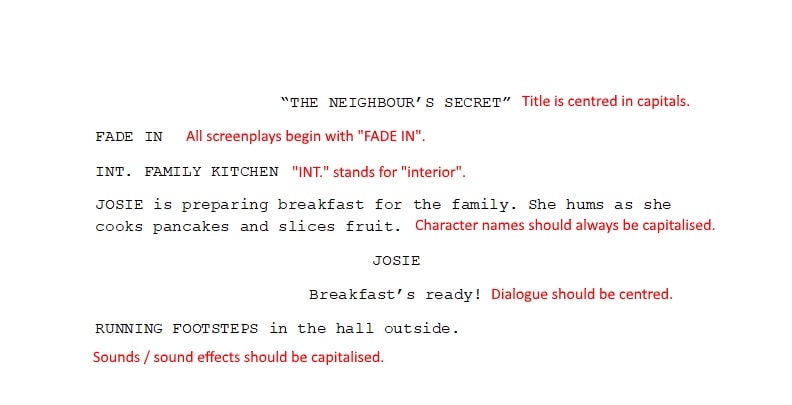
Have you ever ever daydreamed about writing for the massive display screen? I do know I’ve! Writing a screenplay that will get picked up by Hollywood may see your story attain hundreds of thousands of individuals – whereas even bestselling novels usually solely promote within the tens of 1000’s.
Writing a screenplay could be very totally different from writing a brief story or a novel, although. There are some particular conventions that that you must find out about, when it comes to the construction of your story itself, and when it comes to the way you lay it out on the web page.
I’m not going to aim to present you an exhaustive information in a single weblog submit – however I’ll take you thru all of the fundamentals, and offer you loads of hyperlinks to additional studying so you may dig deeper on explicit areas of screenwriting that curiosity you.
What’s the Distinction Between a Screenplay and a Script?
Scripts for performs are laid out barely in another way. They’re designed to be carried out reside, reasonably than pre-recorded and proven on a display screen. They’ll embody stage instructions (like “Exit, stage left” – or Shakespeare’s well-known, “Exit, pursued by a bear”).
Screenplays are scripts for one thing that might be filmed and later “screened” – proven within the cinema or on TV. They’ll usually embody directions for particular pictures – e.g. “CLOSE UP”. Assuming that you simply’re writing for movie, they’ll even have particular size necessities.
Coming Up With an Thought for a Screenplay
Simply as with all sort of fiction you write, having a robust concept is important. Your screenplay ought to be capable to be summed up in a “logline” – a one-sentence abstract of the plot. This logline ought to embody:
- The protagonist (hero) – e.g. A suburban mom of two….
- Their aim – e.g. …should save her husband…
- The antagonist (villain) or antagonistic power – …from a deranged and lethal neighbour.
As James Burbridge says, in an important submit about developing a logline:
Should you can’t write a good logline of your concept earlier than embarking on the script, then perhaps rethink writing that factor. If it’s unfocused and muddled on the loglines stage, it’s not going to get any higher as you write.
Should you’re wanting concepts, you may search for inspiration from:
- Artwork or music – may one thing you’ve seen or heard prompt your story?
- One thing you wrote prior to now – maybe you didn’t have sufficient materials for a novel however it could make an important screenplay.
- A traditional story – there have been many, many movies primarily based on fairy tales (Disney has most likely cornered the market in these!) and Shakespeare.
Your concept must be one thing that may take about 100 – 120 minutes to play out on display screen. A minute on the display screen equates to about one web page of script … so that implies that your screenplay ought to be between 100 and 120 pages (when laid out with correct formatting, which we’ll come onto in a second).
Planning and Structuring Your Screenplay
All writing has construction, and should you’ve written a lot as a brief story, you’ll know the way essential it’s to have a starting, center and finish.
Screenplays have a extra detailed construction, although. You may suppose that is restrictive – however there’s quite a bit you are able to do inside this construction, and it’ll allow you to form your concepts so your story doesn’t drag.
The usual screenplay construction seems like this:
Act I – roughly the primary 25% of your screenplay. (20 – half-hour on the display screen.) That is usually known as the “setup” – it’s the place you introduce your characters and their world and get the story began.
Act II – the center 50% of your screenplay. (As much as an hour on the display screen.) That is usually known as the “confrontation” – it’s the place you complicate the story and the stress rises.
Act III – the ultimate 25% of your screenplay. (A remaining 20 – half-hour.) That is usually known as the “decision” – it’s the place there’s a confrontation between the protagonist and antagonist (or antagonistic power) and – usually – the protagonist prevails.
Inside these acts, there are explicit factors that you simply’re anticipated to hit at particular levels:
- The primary turning level: this comes in the direction of the tip of Act I, and it modifications issues. It’s the place the protagonist discovers one thing, or does one thing, meaning nothing will ever be the identical. That is what actually kicks off the story.
For example, within the story a suburban mom of two should save her husband from a deranged and lethal neighbour, the primary turning level could be the neighbour threatening and even attacking the husband.
- The second turning level: this comes in the direction of the tip of the second act. It raises the stakes and strikes the story into the third act.
For example, this second turning level may need the neighbour kidnapping one of many youngsters: the mom must rescue her little one and shield her husband.
There are many different “factors” that screenwriters are suggested to satisfy, although you’ll most likely discover there’s some debate about what precisely these are! There’s breakdown of the five-point construction right here, which you may wish to comply with.
Laying Out Your Screenplay on the Web page
Screenplays require a really particular format, which is totally different from scripts written to be carried out on stage. (For example, these scripts may have character names on the left, with a colon after them, and screenplays have character names centred, with no colon.)
To your screenplay, you must use the font Courier New, measurement 12. Why? As a result of that method, all scripts match the identical variety of traces on a web page – making it straightforward to estimate their run-time from the web page depend. (Courier is a fixed-width font, so every letter takes up the identical quantity of house.)
Right here’s how the primary few traces of a script may look: I’ve annotated it with some notes about the best way by which it’s laid out.

The best method to ensure you’re formatting your screenplay appropriately is to make use of specialised software program:
- Last Draft is the business normal, utilized by the vast majority of skilled screenwriters … however it’s pricy ($249.99).
- Scrivener can be utilized to format screenplays (in addition to novel manuscripts) – it’s not as specialised as Last Draft, however it’s quite a bit cheaper ($45).
Every of those provide a free trial, so that you may give them a attempt earlier than deciding whether or not or to not buy them.
Writing a screenplay is not any small enterprise – and we’ve solely coated the fundamentals of what that you must know.
If you wish to go additional along with your screenwriting journey, try a few of these nice sources:
Find out how to Write a Screenplay, WikiHow
Whereas I typically discover WikiHow’s articles low-quality, it is a nice in-depth piece that’s been expertly reviewed and thoroughly put collectively. If you need a step-by-step, very beginner-friendly introduction to writing a screenplay, give it a learn!
Find out how to Write a Screenplay You Can Promote, Stephanie Palmer, Good in a Room
This sincere, sensible article explains what that you must do to write down a good screenplay – from selecting one style to watching the identical film again and again to familiarize yourself with construction. Should you’re critical about screenwriting, give it a learn.
Find out how to Write a Screenplay: Script Writing Instance & Screenwriting Ideas, Mario O. Moreno and Kay Tuxford, Writers Retailer
It is a detailed, reassuring article about writing a screenplay, with a lot of particular particulars on structure in addition to some useful tips about size and even on binding and presenting your script.
Find out how to Write Your Screenplay in 24 Hours – Recommendation from a Hollywood Screenwriter and Producer, Dr. Kenneth Atchity, TCKPublishing
On this submit, you’ll discover two actually helpful useful resource: exact directions on what ought to occur by totally different factors in your screenplay (with web page numbers, for a 115 web page script), and a nifty method to chart the rising and falling depth of various scenes in your screenplay.
10 Screenplay Buildings That Screenwriters Can Use, Ken Miyamoto, Screencraft
Should you’d like to have a look at some other ways to inform a narrative, going past the three-act construction, this submit is a good place to start. All through the submit, there are examples of every sort of construction, with tips about what sorts of story each will work greatest for.












